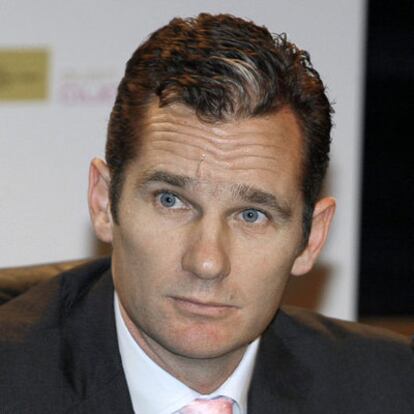Profile: Is the sporty duke playing hardball?
In the summer of 2009, the Duke and Duchess of Palma de Mallorca moved to Washington DC. It was then said that the youngest daughter of the Spanish monarchs, Princess Cristina, was changing homes because of the professional needs of her husband, Iñaki Urdangarin, a former Olympic handball champion.
Three years earlier Urdangarin, who holds a degree in business administration from the ESADE school, had become a board member of Telefónica Internacional in Barcelona and been appointed honorary president of Foro Generaciones Interactivas - an entity made up of Telefónica, Navarre University and the Inter-American University Organization.
But it was right around the time of their move that he was promoted to chairman of the Public Affairs Committee of Telefónica's Latin America and US branches. Some sources said that the appointment was more a result of the royal couple's desire to move to Washington than of real work needs.
But even back then, circles close to the royal family felt that Urdangarin's new post had something to do with the growing scope of his personal business ventures.
There is an unwritten rule in the Royal House that none of its members must ever engage in business. They can and must work, but doing business is another thing altogether. Doña Elena, the monarchs' eldest daughter, knows this well. Shortly after her separation from Jaime de Marichalar, she set up a small consulting firm that never did any work, since just hours after its existence became known, King Juan Carlos himself ordered it dissolved.
Doña Cristina and Iñaki Urdangarin met at the Olympic Games in Atlanta. The handball team, which Urdangarin played in, had just won the bronze medal and Spain's youngest princess attended that evening's celebrations. Witnesses who were there remember that it was she who noticed the dashing, victorious sportsman first.
At that point, Urdangarin was living on his salary as a handball player on the Barcelona FC team and on bonuses he received every time he played on the national team. But he was already showing an interest in business that he inherited from his father, Juan Urdangarin. And so, to his income from sports, he added revenues from a hospitality company he opened with a couple of friends.
After marrying Doña Cristina on October 4, 1997, Urdangarin remained an active handball player, but it was when he was forced to retire, due to growing royal commitments and security concerns at his matches, that his career really took off. The royals looked kindly upon the Duke of Palma's continued link to sports through a role on the Spanish Olympic Committee, but that particular play did not pan out. So after completing a master's degree at ESADE, Urdangarin joined the world of consultancy.
The couple's purchase of a small palace in the exclusive Barcelona neighborhood of Pedralbes afforded some clues as to Iñaki Urdangarin's increasingly prosperous career in business. Doña Cristina, then as now, worked at La Caixa Foundation. The couple also gets a stipend from Don Juan Carlos out of the public money allotted to the Royal House. How this total amount is shared out between family members is not known.
But the fact that the Duke and Duchess of Palma were able to spend six million euros on a 1952 palace with a surface area of 1,200 square meters and a garden of nearly 1,300 square meters came as a surprise to all. Nobody suspected such purchasing power just seven years after their wedding. That house was shuttered up in the summer of 2009, when the family moved to the United States, although it was not rented out until early 2011. It would seem that the couple was reluctant to entirely abandon the home where they were so happy, in the city where they met and their children were born, and which they left a little unwillingly.

Tu suscripción se está usando en otro dispositivo
¿Quieres añadir otro usuario a tu suscripción?
Si continúas leyendo en este dispositivo, no se podrá leer en el otro.
FlechaTu suscripción se está usando en otro dispositivo y solo puedes acceder a EL PAÍS desde un dispositivo a la vez.
Si quieres compartir tu cuenta, cambia tu suscripción a la modalidad Premium, así podrás añadir otro usuario. Cada uno accederá con su propia cuenta de email, lo que os permitirá personalizar vuestra experiencia en EL PAÍS.
¿Tienes una suscripción de empresa? Accede aquí para contratar más cuentas.
En el caso de no saber quién está usando tu cuenta, te recomendamos cambiar tu contraseña aquí.
Si decides continuar compartiendo tu cuenta, este mensaje se mostrará en tu dispositivo y en el de la otra persona que está usando tu cuenta de forma indefinida, afectando a tu experiencia de lectura. Puedes consultar aquí los términos y condiciones de la suscripción digital.
Últimas noticias
Pinochet’s victims grapple with José Antonio Kast’s rise in Chile
Reinhard Genzel, Nobel laureate in physics: ‘One-minute videos will never give you the truth’
How Japan is trying to avert ‘digital defeat’
The complicated life of Francesca Albanese: A rising figure in Italy but barred from every bank by Trump’s sanctions
Most viewed
- Pablo Escobar’s hippos: A serious environmental problem, 40 years on
- Why we lost the habit of sleeping in two segments and how that changed our sense of time
- Trump’s obsession with putting his name on everything is unprecedented in the United States
- Charles Dubouloz, mountaineering star, retires at 36 with a farewell tour inspired by Walter Bonatti
- The Florida Keys tourist paradise is besieged by immigration agents: ‘We’ve never seen anything like this’








































